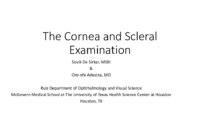Collection of materials relating to neuro-ophthalmology as part of the Neuro-Ophthalmology Virtual Education Library.
NOVEL: https://novel.utah.edu/
TO
- NOVEL724
| Title | Creator | Description | Subject | ||
|---|---|---|---|---|---|
| 176 |
 |
The Eyelid Examination | Sovik De Sirkar, MSIII; Ore-ofe Adesina, MD | Description of the eyelid examination. | Eyelid Examination |
| 177 |
 |
The Cornea and Scleral Examination | Sovik De Sirkar, MSIII; Ore-ofe Adesina, MD | Description of the cornea and scleral examination. | Cornea; Scleral Examination |
| 178 |
 |
Testing Lacrimal Function | Walsh and Hoyt Clinical Neuro-Ophthalmology, 6th Edition | Description of testing lacrimal function. | Lacrimal Function |
| 179 |
 |
The Anterior Chamber Examination | Sovik De Sirkar, MSIII; Ore-ofe Adesina, MD | Description of the anterior chamber examination. | Anterior Chamber Examination |
| 180 |
 |
Corneal Staining | Sovik De Sirkar, MSIII; Ore-ofe Adesina, MD | Description of the corneal staining technique. | Corneal Staining |
| 181 |
 |
The Lens Examination | Sovik De Sirkar, MSIII; Ore-ofe Adesina, MD | Description of the lens examination. | Lens Examination |
| 182 |
 |
The Anterior Vitreous Examination | Sovik De Sirkar, MSIII; Ore-ofe Adesina, MD | Description of the anterior vitreous examination. | Anterior Vitreous Examination |
| 183 |
 |
Fundus Photography | Devin D. Mackay, MD; Valérie Biousse, MD, | Explanation of using fundus photography in examinations. | Fundus Photography |
| 184 |
 |
Ocular Fundus Examination | Devin D. Mackay, MD; Valérie Biousse, MD | Explanation of using the direct ophthalmoscope in examinations. | Direct Ophthalmoscope |
| 185 |
 |
Slit Lamp Binocular | Devin D. Mackay, MD; Valérie Biousse, MD | Description of the slit lamp binocular examination. | Slit Lamp Binocular |
| 186 |
 |
Indirect Ophthalmoscope | Devin D. Mackay, MD; Valérie Biousse, MD | Explanation of using the indirect ophthalmoscope in examinations. | Indirect Ophthalmoscope |
| 187 |
 |
Orbit Evaluation | Allison Crum, MD | Presentation covering the evaluation of the orbit. This includes external examination of facial symmetry and skin. Also covered is the evaluation of the orbit. | Orbit |
| 188 |
 |
Optic Disc Drusen (Portuguese) | NANOS | Optic disc drusen are abnormal deposits of protein-like material in the optic disc - the front part of the optic nerve. | Optic Disc Drusen; Patient Brochure |
| 189 |
 |
Pituitary Tumor (Portuguese) | NANOS | Pituitary tumors are benign (non-cancerous) overgrowth of cells that make up the pituitary gland (the master gland that regulates other glands in the body). | Pituitary Tumor; Patient Brochure |
| 190 |
 |
Optic Neuritis (Portuguese) | NANOS | In the most common form of optic neuritis, the optic nerve has been attacked by the body's overactive immune system and results in decreased vision. | Optic Neuritis; Patient Brochure |
| 191 |
 |
Transient Visual Loss (Portuguese) | NANOS | About transient visual loss. | Transient Visual Loss; Patient Brochure |
| 192 |
 |
Photophobia (Portuguese) | NANOS | The symptoms of light sensitivity are: an uncomfortable sense of brightness, squinting, frequent blinking, and redness of the eye (especially if the eye is dry). Involuntary eye closure and excessive blinking is seen with blepharospasm. Individuals will tend to seclude themselves in darkness. | Photophobia; Patient Brochure |
| 193 |
 |
Myasthenia Gravis (Portuguese) | NANOS | This is an autoimmune condition where the body's immune system has damaged receptors on your muscles and can result in double vision or drooping lid. | Myesthenia Gravis; Patient Brochure |
| 194 |
 |
Progressive Supranuclear Palsy (Portuguese) | NANOS | About Progressive Supranuclear Palsy. | Progressive Supranuclear Palsy; Patient Brochure |
| 195 |
 |
Optic Nerve Sheath Meningioma (Portuguese) | NANOS | About optic nerve sheath meningioma. | Optic Nerve Sheath Meningioma; Patient Brochure |
| 196 |
 |
Anterior Ischemic Optic Neuropathy (Portuguese) | NANOS | Loss of blood supply to the optic nerve results in diminished visual acuity. | Anterior Ischemic Optic Neuropathy; Patient Brochure |
| 197 |
 |
Anisocoria (Portuguese) | NANOS | Pupil in the right eye and left eye are not the same size. | Anisocoria; Patient Brochure |
| 198 |
 |
Blepharoespasm (Portuguese) | NANOS | Uncontrolled blinking, squeezing, and eyelid closure that occurs in both eyes without an apparent environmental cause. | Blepharospasm; Patient Brochure |
| 199 |
 |
Dry Eye Syndrome (Portuguese) | NANOS | People with abnormalities of the tear film are diagnosed with "dry eyes", but some patients with "dry eyes" may not feel that their eyes are "dry". Itching, burning, a scratchy sensation, a sensation that there is sand or grit in the eye, or intermittent blurring of the vision can all be symptoms of... | Dry Eye Syndrome; Patient Brochure |
| 200 |
 |
Homonymous Hemianopia (Portuguese) | NANOS | This refers to an absence of vision towards one side of the visual world in each eye. The damage that caused this problem is in the brain and not in the eyes. | Homonymous Hemianopia; Patient Brochure |
